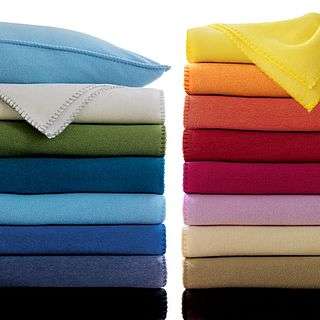Polar fleece
Polar fleece is a soft napped insulating fabric made from polyester.

Uses
Polar fleece is used in jackets, hats, sweaters, sweatpants, cloth diapers (nappies), gym clothes, hoodies, blankets, and high-performance outdoor clothing. It can be made partially from recycled plastic bottles and is very light, soft, and easy to wash. Polar fleece can stretch more easily in one direction than in others.[1]
History
Polar fleece originated in Massachusetts in 1979 when Malden Mills, (now Polartec LLC), and Patagonia developed Synchilla (synthetic chinchilla).[2] It was a new, light, strong pile fabric meant to mimic, and in some ways surpass, wool. Malden Mills CEO Aaron Feuerstein intentionally declined to patent polar fleece, allowing the material to be produced cheaply and widely by many vendors, leading to the material's quick and wide acceptance.[3][4][5]
Characteristics
A lightweight, warm and soft fabric, fleece has some of wool's good qualities but weighs a fraction of the lightest available woolens. Polar fleece garments traditionally come in different thicknesses: micro, 100, 200, and 300, with 300 being the thickest and least flexible.
It is hydrophobic, holding less than 1% of its weight in water. It retains much of its insulating quality even when wet. It is machine washable and dries quickly. It is a good alternative to wool for those who are allergic or sensitive to wool. It can also be made out of recycled polyethylene terephthalate (PET) bottles, or even recycled fleece.
Regular polar fleece is not windproof[6] and does not absorb moisture (although this is often seen as a benefit, per above).[7][8][9] Fleece readily generates static electricity, which causes the accumulation of lint, dust, and pet hair. It is also susceptible to damage from high temperature washing, tumble drying, or ironing under unusual conditions. Lower-quality polyester fleece material is also prone to pilling.
Environmental issues
Non-recycled fleece is made from non-renewable petroleum derivatives. Even if made of recycled materials, fleece relies on a continued production of non-renewable fossil fuels for the raw material.
When fleece goes through the laundry, it generates microplastics that become part of domestic waste water.[10] Municipal waste water systems often discharge into rivers and oceans. PET does not biodegrade, and suspended microplastics are easily ingested by marine life, thus entering the food chain. Fibers can also become airborne, directly from clothes dryer vents or wind. Fibers can travel long distances and migrate to fields, where they are ingested by livestock or delivered to the human food supply on produce products.
See also
References
- Polar Fleece history and the history of pile fabrics
- Greenbaum, Hilary; Rubinstein, Dana (2011-11-25). "The Evolution of Fleece, From Scratchy to Snuggie". The New York Times. ISSN 0362-4331. Retrieved 2015-08-03.
- "Xavier hosting Aaron Feuerstein on March 30". Citizens For A Better Norwood. 2009-06-29.
- Rabbi Avi Shafran (2002-06-22). "Mr. Feuerstein is a legend in the corporate world, keeping his employees on the payroll until the plant could be rebuilt after a fire. His company went bankrupt, and was purchased out of bankruptcy, yet he doesn't regret a thing".
- "Aaron Feuerstein". 2006-07-07.
- Polartec Windpro web page Archived 2012-02-17 at the Wayback Machine
- Columbia Layering Guide for Warmth and Comfort by Frank Ross Archived 2009-03-21 at the Wayback Machine
- Choosing and Using a Quarter Sheet. Discussion of characteristics of wool vs. fleece
- Moisture Buffering Archived 2007-10-25 at the Wayback Machine
- Hartline, N. L., Bruce, N. J., Karba S. N., Ruff, E. O., Sonar, S. U., and Holden, P. A. (2016) Microfiber Masses Recovered from Conventional Machine Washing of New or Aged Garments, Environmental Science & Technology, Vol. 50, No. 21, pp. 11532–11538.


.svg.png)